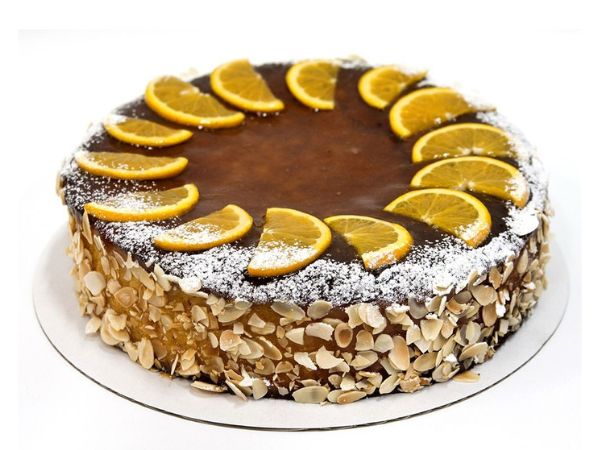Valencia cake is a delightful dessert that originated in the Valencia region of Spain. It is known for its vibrant citrus flavors and moist, fluffy texture. If you’re looking to create a delicious Valencia cake in the comfort of your own kitchen, we have you covered. In this article, we will guide you through making a Valencia cake recipe, explore its unique qualities, share variations and serving suggestions, and provide helpful tips and tricks for baking a perfect cake every time.
Key Ingredients for a Valencia Cake
To make a Valencia cake, you will need the following key ingredients:
- Valencia Oranges: The star ingredient of this cake, Valencia oranges are sweet and tangy, with a distinct citrus flavor that sets the cake apart.
- Almonds: Ground almonds are used in the batter, adding a nutty richness and contributing to the cake’s unique texture.
- Eggs: Eggs provide structure and moisture to the cake, ensuring a light and fluffy result.
- Sugar: Granulated sugar sweetens the cake and balances the tartness of the oranges.
- Flour: All-purpose flour serves as the base ingredient, binding the cake together.
- Baking Powder: Baking powder helps the cake rise and creates a tender crumb.
Unique Qualities of Valencia Cake
What makes Valencia cake stand out among other cake recipes is its wonderful combination of flavors and textures. The use of fresh Valencia oranges infuses the cake with a bright and tangy citrus essence, making each bite refreshing and delightful. The addition of ground almonds gives the cake a moist and dense texture, while still maintaining a light and fluffy crumb. These distinctive characteristics make Valencia cake a unique and enjoyable treat for any occasion.

Incorporating Traditional Spanish Flavors
To incorporate traditional Spanish flavors into your Valencia cake, you can consider adding a touch of orange blossom water or a splash of Spanish brandy to the batter. These additions enhance the aromatic qualities of the cake and infuse it with a subtle hint of traditional Spanish flair.
History of the Valencia Cake Recipe
Valencia cake has a rich history rooted in the Valencia region of Spain. It is believed to have been created during the 19th century, utilizing the abundance of sweet Valencia oranges that grow in the region. The combination of oranges, almonds, and other simple ingredients resulted in a cake that quickly gained popularity and became a staple dessert in Spanish cuisine.
Variations of the Traditional Valencia Cake Recipe
While the traditional Valencia cake recipe is a classic, there are variations that you can explore to add your own twist. Some popular variations include adding chocolate chips, incorporating lemon zest for a tangier flavor, or substituting the almonds with other nuts such as walnuts or pistachios. These variations offer a unique take on the traditional recipe and allow you to customize the cake according to your preferences.

Achieving a Moist and Fluffy Texture
To achieve a moist and fluffy texture in your Valencia cake, there are a few key steps to follow. First, make sure to use fresh and ripe Valencia oranges, as their juice and zest will contribute to the cake’s moisture. Beating the eggs and sugar together until light and fluffy will help incorporate air into the batter, resulting in a lighter texture. Additionally, gently folding in the dry ingredients and avoiding overmixing will prevent the cake from becoming dense.
Decorating a Valencia Cake for Special Occasions
When it comes to decorating a Valencia cake for special occasions, you have numerous options to choose from. A simple yet elegant approach is to dust the cake with powdered sugar, which adds a touch of elegance and complements the citrus flavors. Alternatively, you can use freshly whipped cream or cream cheese frosting to frost the cake, adding a creamy and indulgent element.
Garnishing with fresh orange slices or zest on top of the frosting can enhance the visual appeal and reinforce the citrus theme. Another idea is to decorate the cake with slivered almonds, creating a beautiful and textured finish. For more elaborate occasions, consider using edible flowers or candied orange peel as decorative accents. Remember, the key is to let your creativity shine and tailor the decoration to the specific occasion and your personal style.
Vegan or Gluten-Free Version of Valencia Cake
If you’re following a vegan or gluten-free diet, you can still enjoy a delicious Valencia cake by making a few simple substitutions. For a vegan version, replace the eggs with flax or chia seed gel (1 tablespoon of ground flax or chia seeds mixed with 3 tablespoons of water for each egg) or use unsweetened applesauce or mashed banana as an egg replacer.

Additionally, swap out the butter for a plant-based alternative such as coconut oil or vegan margarine. For a gluten-free version, use a gluten-free flour blend in place of the all-purpose flour. These substitutions will allow you to accommodate dietary restrictions without compromising the flavor and texture of the cake.
Preparation and Baking Time
The preparation and baking time for a Valencia cake may vary depending on the recipe and your experience in the kitchen. On average, it takes approximately 15-20 minutes to prepare the batter, and the baking time can range from 40 to 60 minutes. It’s important to note that oven temperatures and individual preferences may affect the baking time, so it’s always recommended to perform the toothpick test (inserting a toothpick into the center of the cake; if it comes out clean or with a few crumbs, the cake is done) to determine if the cake is fully baked.
Tips and Tricks for Baking a Perfect Valencia Cake
To ensure a perfect Valencia cake, here are some tips and tricks to keep in mind:

- Use fresh and ripe Valencia oranges for the best flavor and juiciness.
- When measuring the flour, spoon it into the measuring cup and level it off with a knife to avoid packing it down.
- Allow all the ingredients, especially the eggs and butter, to come to room temperature before starting the recipe. This helps with better mixing and aeration.
- Be careful not to overmix the batter once the dry ingredients are added, as this can result in a dense cake.
- Grease and flour the cake pan properly to prevent sticking.
- Place the cake pan in the center of the oven for even heat distribution.
- Avoid opening the oven door frequently during baking, as this can cause the cake to sink.
- Let the cake cool in the pan for about 10 minutes before transferring it to a wire rack to cool completely.
Traditional Serving Suggestions
Valencia cake is often enjoyed as a standalone dessert, but you can also serve it with accompaniments to enhance the experience. A dusting of powdered sugar, a dollop of freshly whipped cream, or a side of vanilla ice cream can complement the flavors and textures of the cake. For an extra touch, consider serving it with a drizzle of warm chocolate sauce or a sprinkle of toasted almonds.
Flavor Profiles of Valencia Cake
Valencia cake boasts a harmonious blend of citrus and nutty flavors. The sweetness of the Valencia oranges is balanced by their natural tartness, creating a refreshing citrus taste. The ground almonds add a subtle nuttiness that complements the citrus notes and contributes to the cake’s richness. Overall, the flavor profile of Valencia cake is vibrant, zesty, and satisfyingly sweet.

Using Valencia Oranges from Other Regions
While traditionally Valencia oranges from the Valencia region of Spain are used in this cake, you can still achieve excellent results with oranges from other regions. Look for oranges that have a similar flavor profile to Valencia oranges, such as Navel oranges or Cara Cara oranges. These varieties are known for their sweet and juicy flesh, which will lend a delicious citrus taste to your cake. However, keep in mind that the specific flavor may vary slightly, as different growing conditions and regions can affect the taste of the oranges. Regardless, using fresh and ripe oranges will still provide the essence of citrus that makes a Valencia cake so special.
Special Techniques in Making Valencia Cake
While making Valencia cake doesn’t require any particularly complicated techniques, there are a few steps you can take to ensure the best possible outcome:
Zesting and Juicing the Oranges: When zesting the oranges, be sure to only remove the colorful outer layer of the peel, avoiding the bitter white pith underneath. When juicing the oranges, strain the juice to remove any pulp or seeds that may affect the texture of the cake.
Grinding the Almonds: For the ground almonds, it’s best to use blanched almonds (skins removed) to achieve a smoother texture. You can grind them in a food processor or blender until finely ground but not too fine, as this can result in a dense cake.
Mixing the Batter: When mixing the batter, start by creaming the butter and sugar together until light and fluffy. Then, add the eggs one at a time, beating well after each addition. Gently fold in the dry ingredients and orange zest, alternating with the freshly squeezed orange juice, until just combined. Avoid overmixing to prevent a dense texture.

Differences from Other Citrus-Based Cakes
Valencia cake stands out from other citrus-based cakes due to its specific combination of Valencia oranges and ground almonds. The use of Valencia oranges provides a unique and distinct flavor profile, with a perfect balance of sweetness and tartness. The addition of ground almonds gives the cake a moist and dense texture, setting it apart from other lighter and fluffier citrus cakes. These characteristics, combined with the traditional Spanish influence, make Valencia cake a standout choice among citrus-based desserts.
Common Mistakes to Avoid
To ensure the success of your Valencia cake, it’s important to avoid common mistakes that can affect its texture and flavor:
- Using stale or unripe oranges: The quality of the oranges is crucial, as it greatly impacts the taste of the cake. Make sure to use fresh and ripe oranges for the best flavor.
- Overmixing the batter: Overmixing can lead to a dense and heavy cake. Once the dry ingredients are incorporated, mix only until just combined.
- Incorrect oven temperature: Ensure that your oven is preheated to the correct temperature as stated in the recipe. An oven that is too hot or too cold can affect the baking time and result in an unevenly baked cake.
- Opening the oven door too often: Resist the temptation to peek into the oven while the cake is baking. Opening the door frequently can cause temperature fluctuations and may result in a sunken or undercooked cake.
- Not greasing and flouring the pan properly: To prevent sticking, make sure to thoroughly grease and flour the cake pan, ensuring every nook and cranny is covered.

Rituals or Customs Associated with Valencia Cake
Valencia cake does not have any specific rituals or customs associated with it. However, in Spain, where the cake originates, it is often enjoyed as a dessert during special occasions and celebrations. It is a popular choice for birthdays, holidays, and family gatherings. In these contexts, serving the cake with a sense of joy and celebration can create its own special atmosphere and enhance the overall experience.
Incorporating Seasonal Fruits
While Valencia cake traditionally relies on the flavors of Valencia oranges, you can incorporate seasonal fruits to add variety and freshness to your cake. Consider incorporating fruits such as strawberries, raspberries, or blueberries as toppings or fillings. You can slice the fruits and arrange them on top of the cake or create a fruit compote to use as a filling between cake layers. The combination of citrus flavors from the Valencia oranges and the vibrant sweetness of seasonal fruits will elevate the taste and visual appeal of your Valencia cake, making it a delightful treat for any season.
Freezing a Valencia Cake
Yes, you can freeze a Valencia cake for later consumption. To freeze the cake, make sure it has completely cooled down after baking. Wrap the cake tightly with plastic wrap or aluminum foil, or place it in an airtight container to prevent freezer burn and maintain its moisture. It’s advisable to freeze the cake without any frosting or decoration, as these can be added after thawing. When you’re ready to enjoy the cake, simply thaw it in the refrigerator overnight or at room temperature for a few hours. Once thawed, you can frost and decorate the cake as desired.
Conclusion
Valencia cake is a delightful dessert that showcases the vibrant flavors of Valencia oranges and the nutty richness of ground almonds. Its unique qualities, including a moist and fluffy texture, make it a standout among other cake recipes. By following a few key steps and incorporating traditional Spanish flavors, you can create a delicious Valencia cake in your own kitchen. Whether you’re celebrating a special occasion or simply indulging in a sweet treat, Valencia cake is sure to impress with its citrusy goodness and delightful aroma. So grab your apron, gather your ingredients, and embark on a culinary journey to savor the flavors of Spain with a homemade Valencia cake.
FAQs
Can I use other types of oranges for a Valencia cake?
While Valencia oranges are traditionally used for their distinct flavor, you can experiment with other sweet and juicy orange varieties like Navel oranges or Cara Cara oranges.
Can I substitute almond flour for ground almonds in the recipe?
Yes, you can substitute almond flour for ground almonds in the same quantity. However, keep in mind that almond flour is finer and may result in a slightly different texture.
Can I make Valencia cake ahead of time?
Yes, you can make Valencia cake ahead of time. It can be stored at room temperature for a day or two or refrigerated for up to a week. Alternatively, you can freeze the cake for longer storage.
Remember, baking is an art, and practice makes perfect. So don’t be afraid to experiment, adjust ingredients to your taste, and enjoy the process of creating a homemade Valencia cake that will delight your taste buds and impress your loved ones.




